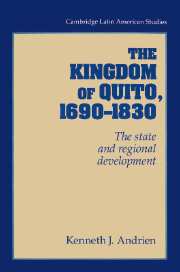Book contents
- Frontmatter
- Contents
- Acknowledgments
- Introduction
- PART I THE STATE AND SOCIOECONOMIC DEVELOPMENT
- 1 The late seventeenth-century crises
- 2 The people and markets of the kingdom
- 3 The state and manufacturing
- 4 Spanish agriculture and the rural economy
- 5 Amerindians and the market economy
- 6 Commerce and economic patterns
- PART II REFORM AND POLITICAL CONFLICT
- Appendixes
- Glossary
- Bibliography
- Index
6 - Commerce and economic patterns
from PART I - THE STATE AND SOCIOECONOMIC DEVELOPMENT
Published online by Cambridge University Press: 29 September 2009
- Frontmatter
- Contents
- Acknowledgments
- Introduction
- PART I THE STATE AND SOCIOECONOMIC DEVELOPMENT
- 1 The late seventeenth-century crises
- 2 The people and markets of the kingdom
- 3 The state and manufacturing
- 4 Spanish agriculture and the rural economy
- 5 Amerindians and the market economy
- 6 Commerce and economic patterns
- PART II REFORM AND POLITICAL CONFLICT
- Appendixes
- Glossary
- Bibliography
- Index
Summary
Crown policies and structural economic changes had profound repercussions on commercial patterns in the Kingdom of Quito between 1690 and 1830. As falling prices for paño forced many obrajes in the northcentral sierra to close down, the traditional textile trade gave way to a more diversified network of commercial transactions. European imports continued squeezing Quiteño woolens from the Lima market, but cloth producers in the kingdom still managed to supply ample amounts of cheaper textiles to New Granada. At the same time, the cottage cloth industry in the south sierra flourished until the early nineteenth century, providing low-cost cottons and woolens for markets in Peru. The most important commercial changes, however, occurred along the coast. At the end of the seventeenth century, the modest economy of Guayaquil revolved around shipbuilding and the trade in highland cloth. Nevertheless, within one hundred years the port had developed into a major Pacific trade center, exchanging cacao and a wide range of other coastal and highland exports for European and colonial imports.
The crown attempted to regulate these changing trade patterns in the kingdom with a series of commercial reforms. As metropolitan authorities liberalized trade policies from 1778 to 1789, they also established an extensive network of customs houses (aduanas) to tax and monitor market exchanges throughout the kingdom. Moreover, the crown placed these new customs stations under direct state control, rather than farming out the duties to colonial elites and vested interest groups. As the custom's accounts demonstrate, these policies succeeded in dramatically extending the state's fiscal and regulatory power, and commercial tax receipts reached new heights, at least until the independence era.
- Type
- Chapter
- Information
- The Kingdom of Quito, 1690–1830The State and Regional Development, pp. 134 - 162Publisher: Cambridge University PressPrint publication year: 1995



